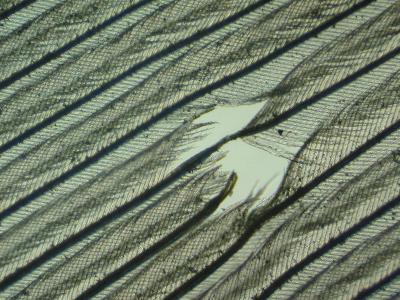Feather holes on:
[Wikipedia]
[Google]
[Amazon]
 Feather holes often characteristically occur on wing and tail feathers of some small-bodied species of
Feather holes often characteristically occur on wing and tail feathers of some small-bodied species of
 Feather holes often characteristically occur on wing and tail feathers of some small-bodied species of
Feather holes often characteristically occur on wing and tail feathers of some small-bodied species of passerines
A passerine () is any bird of the order Passeriformes (; from Latin 'sparrow' and '-shaped'), which includes more than half of all bird species. Sometimes known as perching birds, passerines are distinguished from other orders of birds by th ...
. In the case of barn swallow
The barn swallow (''Hirundo rustica'') is the most widespread species of swallow in the world. In fact, it appears to have the largest natural distribution of any of the world's passerines, ranging over 251 million square kilometres globally. ...
s, it was suggested that the holes were feeding traces of avian lice, either '' Machaerilaemus malleus'' and/or '' Myrsidea rustica'' (both Phthiraptera
Louse ( : lice) is the common name for any member of the clade Phthiraptera, which contains nearly 5,000 species of wingless parasitic insects. Phthiraptera has variously been recognized as an order, infraorder, or a parvorder, as a result of ...
: Amblycera).
Hole counts were shown to be highly repeatable, and thus counts appeared to be useful measures to quantify the intensity of infestation. Since then, a number of influential papers have been published on the evolutionary, ecological, and behavioral aspects of host-parasite interactions based on the assumption that holes were chewed by ''Machaerilaemus malleus''. More specifically, host sexual selection, feather breakage, flight performance, immunity levels, arrival dates, and even song characteristics were shown to covary with the number of holes. Cross-fostering experiments showed that infestation levels were heritable.
Recently, however, it was shown that ''Machaerilaemus malleus'' is apparently absent from Europe, where all these studies were carried out. Correlational evidence supports the hypothesis that feather holes are feeding traces of lice, however, the occurrence of '' Brueelia'' spp. lice (Phthiraptera
Louse ( : lice) is the common name for any member of the clade Phthiraptera, which contains nearly 5,000 species of wingless parasitic insects. Phthiraptera has variously been recognized as an order, infraorder, or a parvorder, as a result of ...
: Ischnocera) provides the best fit to the distribution and abundance of feather holes both in barn swallows and across several small passerines.
References
{{DEFAULTSORT:Feather Holes Feathers Parasites of birds Lice